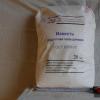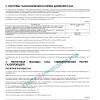New technologies that are used in heating private houses can be easily used in homemade boilers.
The effect of wood pyrolysis smoldering makes it possible to increase the burning time of firewood up to 8 hours, and the intensity of fuel combustion can be regulated by means of valves.
It is not so easy to make a pyrolysis boiler on your own, you need to be able to handle a welding machine, drill, grinder. But if you already have experience, then assembling such a device yourself will not be difficult.
Principle of operation
Before proceeding with the manufacture of a pyrolysis boiler, it is necessary to understand the processes that occur inside this device.
Under the influence of high temperatures, wood decomposes with the formation of pyrolysis gas and charcoal. This process can be controlled by preventing the wood from burning too quickly. This effect is achieved by limiting the supply of air to the combustion chamber. Fuel, which at enough oxygen would burn out in 30 minutes, smolder for several hours, evenly giving off heat.
The power of the device depends on its size combustion chamber... Some models of pyrolysis boilers are equipped with a water jacket, which allows heating rooms that are far from the room where the pyrolysis boiler is installed.
As fuel for the pyrolysis boiler can be used various substances and materials. Rubber has a high efficiency, but this substance, when burned, forms a large number of soot, therefore, preventive maintenance is required here much more often.
Pyrolysis boilers can be operated on granular fuel. Such devices can operate autonomously without stopping the combustion process for up to several days in a row.

Preparation phase
On preparatory stage it is important to calculate correctly required power appliance, and also choose the model that will be used for heating the house.
According to the rules of operation of these devices for the installation of a pyrolysis boiler, it is necessary to equip a separate room with high ceilings, with free access of air, but it is not recommended to stay in such a room for a long time, let alone stay overnight.
To make a pyrolysis boiler with your own hands you will need following tools and materials:
- Welding machine... It is best to use an inverter type device.
- Bulgarian.
- Electric drill.
- Hammer.
- Screwdrivers and wrenches
- Gas cylinder from truck volume of 175 liters.
- High-carbon sheet steel 5 mm thick.
- Steel pipe with a diameter of 28 mm.
- Steel pipe with a diameter of 112 mm.
- Marker.
- Metal corner 50 * 50 mm.
- Metal ashtray door.
In addition, it is necessary to prepare expendable materials: welding electrodes, emery wheels and drills.
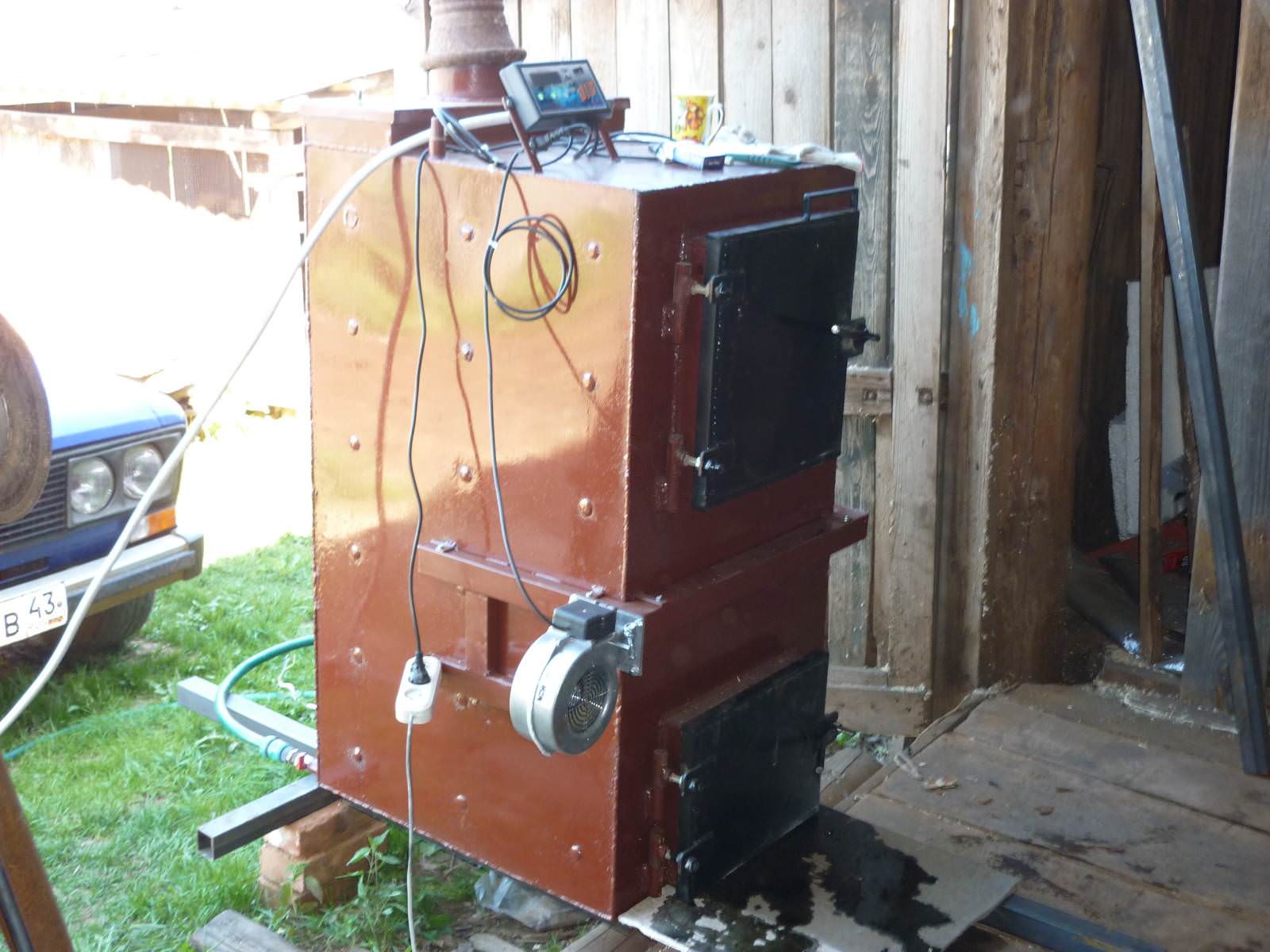
Boiler manufacturing
The pyrolysis boiler is manufactured in the following sequence:
- If for the manufacture of the device will be used gas bottle, used, then it is necessary to bleed off the remaining gas, unscrew the bolts that hold the neck of the cylinder, and drain the gasoline. After that, the gas cylinder must be filled with water and kept for several days.
- Then the cylinder is sawn across with a grinder slightly above the weld seam. Thus, a perfectly flat metal cylinder with a length of more than 130 cm will be obtained. pyrolysis combustion wood, but the heat generated during this process must be transferred to the coolant. The coolant will be in a jacket, which will be “dressed” on the cylindrical combustion chamber.
- To make a shirt, 6 plates must be cut out of sheet steel: 2 rectangular plates measuring 60 * 60 cm, and 4 plates 120 * 60 cm.In plates measuring 60 * 60 cm, cut round holes exactly in the middle of the square. The diameter of these holes must be equal to the outside diameter of the cylinder made from the gas cylinder.
- To make the holes ideal for placing a propane tank in them, you should install the cut off edge of the cylinder exactly in the middle on the plate and circle it with a marker. Then, according to the outlined drawing, cut the hole with a gas cutter.
- When making holes in the bottom and top edge will be finished, from all previously prepared plates a container with a height of 120 cm and a width of 60 cm is welded. The edges with slots will be located, respectively, in the upper and lower parts of the tank.
- When the cylinder jacket is ready, it is placed inside a rectangular tank in such a way that there is an indent from the plane of the shirt from above about 5 cm.
- The cylinder is then carefully welded to the plane of the shirt. Two pipes are welded to the water jacket.
- One at the bottom of the tank, it will be used to enter the cooled heat carrier, the other in the upper part of the jacket, through it the heated liquid will be taken. Both connections have a pipe diameter of 28 mm.
- When water jacket will be completely made, from the metal "pancake", which was formed when cutting out the holes for the cylinder, a dividing plate is made. This plate will protect the burning pyrolysis gas from the fuel located inside the combustion cylindrical chamber. On one side, a 50 * 50 mm corner is welded to the "pancake".
- The corner must be installed crosswise. Thus, a constant gap between the baffle and the glowing fuel will be maintained.
- A cap is made from the upper part of the cylinder, which has been sawn off., for loading fuel into the pyrolysis boiler, as well as for removing wood combustion products into a chimney specially mounted for such a furnace.
- In order for the cover to cover the combustion cylinder from above, it is necessary to weld a strip of metal 1 mm thick and 50 mm wide to the sawn-off cover around the circumference. A hole is made in the upper part of the lid with a cutter and a piece of pipe with a diameter of 112 mm and a length of 0.5 meters is welded.
- A hole is made at the bottom of the cylinder for the size of the ash pan door, which then. The door must have a reliable locking device, excluding spontaneous opening during the operation of the heater.
- To adjust the intensity of fuel combustion, a pipe with a diameter of 28 mm is welded next to the ash pan door, on which a thread is cut and installed water tap with a worm locking mechanism. Thus, it will be possible to completely block the flow of air into the combustion chamber, which will lead to a decrease in the intensity of firewood burning, and this process will last at least 8 hours.
Boiler installation
- The heating boiler must be placed in an upright position during operation, therefore, "legs" from a metal corner are welded to the side corners of the water jacket.
- The height of the lower plane of the shirt should be raised above the floor level not by a distance of 0.5 meters. After the "legs" have been attached to the boiler, it must be properly installed in a separate room.
- The boiler is installed on a flat concrete floor. The heater must be at least 0.5 meters away from combustible objects. The plane of the water jacket must not come into contact with the wall, otherwise winter time heating efficiency will be significantly reduced.
- To remove smoke, a hole is made in the roof and ceiling of the boiler room, into which a tin pipe is installed, which is selected so that its inner diameter is 5-10 mm larger than the outer diameter of the pyrolysis boiler chimney. This pipe should be 2 meters long.
- Further, the chimney consists of a tin piece of pipe with an inner diameter allowing the down pipe to fit freely but tightly into it.
- Thus, tin pipe is a connecting link between the pipe boiler chimney and chimney, which is installed in the roof of the building.
- The whole process of loading firewood into the combustion chamber and firing up the boiler is carried out in the following sequence:
- The tin pipe is pushed up and fixed in this position by means of a retractable powerful neodymium magnet.
- The boiler lid is removed and the combustion chamber is filled with wood or other combustible materials.
- Leave the top of the camera small space for installing a dividing wall.
- Then the fuel is ignited, a delimiter is placed on the fire and the lid is installed.
- A tin pipe is pushed onto the chimney of the boiler lid, while the branch pipe must fully enter the tin pipe.
- The fuel will burn for at least 8 hours only if the ash pan door is tightly closed and the air valve is slightly open. You can significantly increase the intensity of combustion, at the beginning of each cycle it is necessary to allow the fuel to ignite well, so the air valve remains open for 10-15 minutes. The air valve is then closed completely and unscrewed 2/3 of a turn.
- After finishing full cycle burning, the loading process is repeated again. If a large amount of ash has formed in the lower part of the boiler, it must be removed through the lower door, which then closes tightly again.
- In the process of pyrolysis combustion of wood, the plate, which separates the glowing fuel from the flame, will go down the boiler and by the end of the cycle will be at the very bottom. To remove this "pancake" from the boiler, it is necessary to make a device, which consists of a piece metal-plastic pipe with a diameter of 40 mm and a length of 1.5 meters.
- Inside the pipe, at one of the edges, there is a cylindrical neodymium magnet, selected in such a way that it fits into the pipe with an interference fit. Super glue can be used to secure the magnet more securely. Such homemade tool allows you to lift the separating plate from the bottom of the boiler.
- The chimney, which is used to remove combustion products, must be made of sheet metal, and the upper part, which will be in contact in winter with cold air made of two-layer sheet metal with a heat insulator between the two layers.
- The chimney must be positioned vertically with minimum gaps at the joints of the pipes.
- This model of a pyrolysis boiler is intended for use in a heating system with forced circulation coolant, therefore it is necessary to install a pump of sufficient power in the system.
Recently, they are gaining more and more popularity among the owners of private houses, shops and small industries.
This kind of solid fuel heating equipment is the most promising for a number of reasons:
- its coefficient useful action is more than 90%;
- fuel burned in its furnaces, and we are talking mainly about pellets, environmentally friendly and cheap;
- modern technologies make it possible to create such perfect boilers that they can be installed even in city apartments.
Considering all this, it is not surprising that people want to make such a unit with their own hands. So, let's see if it is possible to make a properly working pyrolysis boiler in a home workshop.
![]()
Stages of the pyrolysis boiler
This unit in its work uses the principle of decomposition of solid organic fuel into coke and pyrolysis gas, with further afterburning of the latter.
In fact, the process of heat generation in such a boiler is divided into two stages:
- Normal combustion of solid organic fuel in the first furnace with insufficient oxygen supply (smoldering with the release of a large volume of pyrolysis gas).
- Combustion of volatile substances in the second furnace.
Control is no more difficult than gas or electric. The combustion process is controlled by a thermostat and regulates its intensity by opening or closing the damper through which air is supplied to the first furnace.
This unit owes its environmental friendliness to the fact that most harmful substances, ash and soot remain in the form of coke in the first furnace and do not enter the atmosphere.
Device and circuit

Two chambers of a solid fuel pyrolysis boiler can be located in different ways, depending on the type of air supply to both furnaces:
- due to the presence of natural traction;
- with forced air supply by means of a fan.
Plants operating on the first principle consist of a lower primary combustion chamber and an upper secondary combustion chamber, with the air flowing from bottom to top.
The second principle involves placing the primary chamber on top, and the secondary one below it, while the air is injected from top to bottom.
Method of air supply to combustion chambers
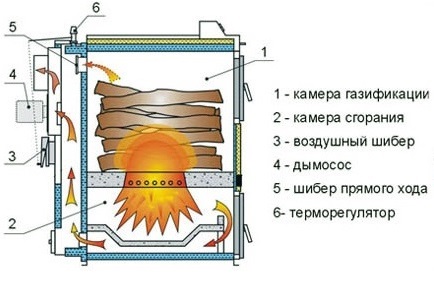
Particular attention should be paid to indicators such as the diameter and height of the chimney, especially for boilers operating on natural draft.
It should be sufficient to overcome the resistance of the boiler and chimney, as well as to create a vacuum inside the furnace of the order of 16 - 20 Pa. The diameter of the chimney must correspond to the outlet pipe, and its height must be 5 meters or more.
As for the forced air supply, it can be carried out in three different ways:
- Installation of a blower fan (the cheapest option).
- Installation of a smoke exhauster at the outlet of the boiler (the safest design, since it does not allow the emission of flame towards the operator when the firebox doors are opened).
- Installation of fans on both sides (more often used on high-power boilers).
Combustion control

The boiler control automation should be as high quality as possible, since not only the warmth in the house, but also the safety of the residents depends on its proper operation.
The processor is able to control the blowdown modes, the pump that pumps the coolant in the heating system, the fan speed, it can be connected to room thermostat... At the request of the owner, you can switch from automatic control mode to manual control and vice versa.
The pyrolysis boiler nozzle is a slot-like opening between the gasification and combustion chambers, through which the pyrolysis gas is forcibly supplied.
Self-manufacturing methods
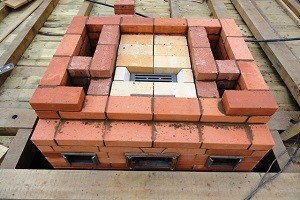
On the network you can find a lot of options for the manufacture of pyrolysis boilers from a variety of materials at hand. Let's consider the most common ones.
The first option is a simple boiler from a gas cylinder. It would seem that rounded steel containers made of thick enough steel are ideal for making fireboxes, especially since it is not easy for a homemade master to give the desired shape iron sheet 5 mm thick, and here almost everything is ready.
But, unfortunately, nothing good will come of this venture. Conventional structural steel used for the manufacture of cylinders does not have necessary level heat resistance and chemical resistance, therefore, the walls of furnaces made of them will quickly burn out.
But it is still possible to find an application for a cylinder in a heating system. It will make an excellent fuel reservoir for a mining boiler.
The second option is a brick pyrolysis boiler. This pyrolysis chamber has an efficiency of up to 90%. This indicator is achieved thanks to high level thermal inertia of a brick, which allows maintaining an optimal temperature level in the gasification and combustion chambers, regardless of the intensity of the thermochemical reactions inside them.
In addition, the brick boiler can be converted in such a way that two gasification chambers come out. And to make them work on different - one on wood, and the other on coal.
Thanks to of varying duration gas formation, as well as a shift in the fuel loading time, it is possible to ensure that the boiler will never cool out.
And the third option is a mini-oven operating on sawdust, shavings, rags. Made from a pair of canned food cans of various diameters inserted into each other. Fuel smolders in the lower jar, and pyrolysis gas is drawn into the holes punched with a knife in the bottom of the upper jar and burns there.
Materials and tools
The set of tools and consumables depends on what kind of boiler it was decided to make.
For example, in order to make an all-metal pyrolysis boiler long burning do it yourself, you will need:

- welding machine;
- powerful "grinder" with cutting and grinding wheels;
- electric drill;
- electrodes;
- control automation;
- blowing fan;
- sheet metal 3-4 mm thick;
- a set of thick-walled pipes with a diameter of 20, 32, 57 and 159 mm;
- steel strip 30X4 mm 80X5 mm;
- steel professional pipe 60X30X2 mm and 80X40X2 mm;
- asbestos cord;
- steel bar;
- stamping brick;
- boiler diagram.
For a brick pyrolysis unit, you will need slightly other consumables:

- ceramic brick;
- fireclay brick;
- steel sheet with a thickness of 4 mm or more;
- cast iron grates;
- blower fan;
- control automation;
- firebox and blower doors;
- boiler diagram.
Assembly nuances
First of all, you should make detailed drawing future unit. After that, all the parts of the boiler are selected or made according to the developed drawing.

- For the manufacture of both chambers, heat-resistant alloy steel with a thickness of at least 5 mm is best suited, however, to reduce the cost of the structure, you can also use simple carbon steel, just be sure to lay out lower part the gassing chambers and the bottom of the combustion chamber, at which the fire torch is directed, with the help of refractory bricks.
- Water jacket, lid, doors are welded from steel 3 mm thick.
- A fire-tube heat exchanger should be placed inside the water jacket, for the manufacture of which seamless pipes with a diameter of 48 or 57 mm, made of carbon steel, are ideal.
- Both chambers should be given as much as possible rounded shape since unheated corners significantly reduce efficiency.
- The nozzle nozzle is made in the form of a longitudinal slot, since this shape is less conducive to ash clogging than a circle.
People who decide to use to heat their homes and structures pyrolysis boilers, for their full and long-term work, a number of simple rules should be followed:

- It is better to make a chimney with a height of 5 to 7 meters and above from sandwich pipes.
- For the first time, the boiler should be heated with maximum power, for at least 5 hours, while the room should be well ventilated.
- The chimney is cleaned every couple of months.
- The firewood should be placed in the gassing chamber as tightly as possible.
- Cleaning small boiler carried out with a scraper or a metal brush, and large units - compressed air, with an open smoke damper.
- Before ending heating season the fuel is completely burned out, and as soon as the structure cools down, the boiler is cleaned. All moving parts are lubricated.
Homemade pyrolysis boilers are becoming more and more popular due to the high cost of such factory-made boilers. The only drawback of such units can be considered only their exactingness to the preparation of fuel (its moisture content should not exceed 25%).
Well, for the rest, a self-made pyrolysis boiler will become worthy alternative any of the varieties of ready-made heating units on the market.
Watch a video that shows in detail how to make a pyrolysis boiler with your own hands:
Solid fuel heating equipment gradually began to be replaced with gas generator models, which have become a worthy alternative. They have proven to be easy to operate, yet extremely effective solutions, therefore, even at a relatively high cost, they are quite popular with consumers. Suffice it to note that the principle of operation of the pyrolysis boiler is such that it is successfully used not only for heating private dwellings, but also for industrial enterprises.
The essence of pyrolysis
Gas generating boilers operate on the principle of pyrolysis fuel combustion. Its essence lies in the fact that under conditions of a lack of oxygen and under the influence of high temperatures, the process of decomposition of dry wood into volatile and solid parts occurs. The process usually takes place at a temperature of 200-800 degrees Celsius, and this is an exothermic process, that is, it also releases heat, which makes it possible to improve the heating of the fuel and its drying in the boiler. This is also accompanied by heating of the air flowing directly into the combustion zone.
Mixing oxygen with pyrolysis gas released from wood under high temperature conditions leads to combustion of the latter, which subsequently leads to the production of thermal energy. During combustion, active interaction with active carbon takes place, and this allows minimizing the release of harmful impurities. For the most part, this is a mixture of water vapor and carbon dioxide.
Characteristics
Like other heating equipment, solid fuel heats the coolant that is subsequently supplied to the system. It differs from other models in the principle of operation and some design features. The principle of operation of the pyrolysis boiler is based on the process of the so-called dry distillation of wood. It consists in the release of pyrolysis gas from solid materials organic under the influence of elevated temperatures in conditions of minimizing the supply of oxygen. This set of conditions leads to the decomposition of wood into gas and residues in the form of dry coke.
The pyrolysis process itself is carried out when it reaches 1100 degrees Celsius, so there is big selection heat, allowing: to dry the wood in the boiler, to heat the air entering the combustion zone. When oxygen and gas released from wood are mixed, the latter burns, due to which a lot of thermal energy is released. When the gas interacts with active carbon, the carcinogenic substances in the exhaust gases are minimized. They even contain three times less carbon dioxide than conventional solid fuel boilers.

Device
To understand the principle of operation of a pyrolysis boiler, it is necessary not only to consider its structure, but also to determine how each individual unit of the device functions. It includes a considerable number of mechanisms and parts. However, a pair of cameras serve as the basis. They are usually made completely sealed from steel sheets, which have a thickness of at least 5 mm. A nozzle is used as a chamber separator. Upper part the furnaces were made in the form of a fuel bunker, that is separate design, and the lower one is used simultaneously as a combustion chamber and an ash pan.
Each chamber is designed for the flow of quite specific processes. In the upper section, the wood is dried with simultaneous heating of the air, which is then directed to the next section. V lower chamber the resulting gas is burned and ash is accumulated.
Functioning
The principle of operation of a solid fuel pyrolysis boiler is based on the possibility of adjusting the power by pressurizing secondary gas. Thus, the result is more efficient in comparison with conventional heating devices. The required temperature of the heating medium can be set using the built-in thermostat.
The device of the pyrolysis boiler is such that during its operation, soot is completely absent in the combustion process, and ash is formed in minimum quantity... These features are focused on making it possible to clean the device as little as possible.
If we talk about how a pyrolysis boiler works in comparison with a conventional solid fuel one, then it is worth noting a longer burning of firewood with one tab, namely, functioning up to 12 hours. Naturally, this is influenced by temperature indicators, but the resource of work is much greater. Firewood is consumed economically by heating the air entering the combustion zone.
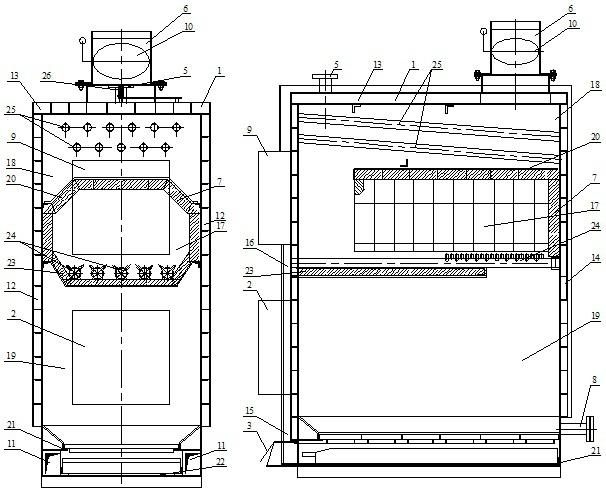
Fuel selection
Despite the fact that the device of a pyrolysis boiler assumes its operation on wood, which is recognized as the most profitable from the point of view of economy, in practice, alternative types of fossil fuels, for example, coal, peat, can be used for its operation. To improve the efficiency of the equipment, it is required to take into account that each type of raw material has its own length of time for complete combustion. In the case of softwood it is 5 hours, with hardwood - 6, with coke - 10.
Studies and user surveys indicate that the most efficient operation of heating equipment is achieved when working on dry wood. The moisture content of the wood should not be more than 20%, and the length of the logs can be up to 65 cm. This fuel will not only provide the maximum power of the equipment, but also significantly increase the time of its uninterrupted operation. However, if it is not possible to purchase this type of resource, you can use alternative view fossil fuel, provided that it has been authorized by the manufacturer. It can be: peat, pellets, wood waste, cellulose-containing industrial waste, coal.
However, when choosing any type of fuel, it is important to remember that excessive moisture can lead to the release of steam during operation of the device, which causes the formation of soot and reduces thermal performance equipment during operation. Only when using dry substances and correct adjustment the consumption of primary and secondary air is minimization of the release of pyrolysis gases.

Benefits of gas generating equipment
Now that it is known how the pyrolysis boiler works and what types of fuel can be used for it, it should be noted that among solid fuel models this is the most economical type. The operation of such equipment is characterized by:
Fast transition to energy efficiency mode;
Stable temperature in the heating system, provided that there is fuel in the firebox;
There is no need for frequent cleaning;
The boiler can be used in conjunction with any system;
Does not need to install a chimney;
Made of corrosion-resistant, heat-resistant materials.
Such a list of parameters indicates the efficiency of pyrolysis boilers in comparison with traditional solid fuel models, so they can be used to work in any environment. The high cost is the only drawback of such equipment, however, if it is impossible to use alternative devices, in addition to solid fuel, the choice will be in favor of the former.
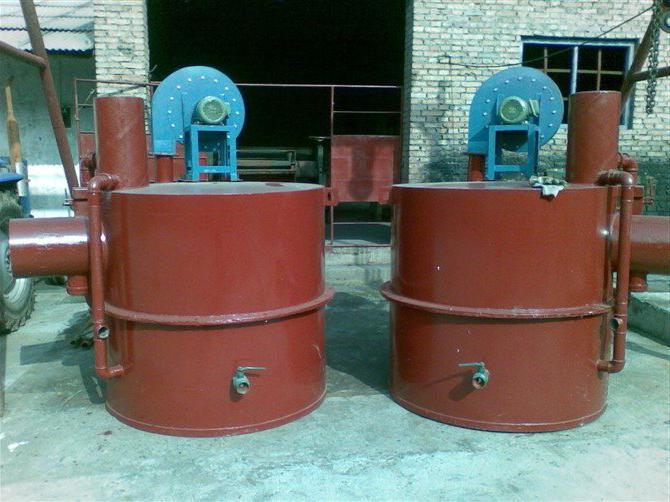
Since such equipment has recently become more and more popular among consumers, it is becoming topical issue not only its acquisition, but also self-made... This is due to the rather high cost ready-made solutions, unbearable for the majority of citizens. To do it you just need a desire and some tools. First, you need to have basic information about how this looks and works. heater... It must be calculated in advance what type of combustion will be optimal for a particular task - with a slot burner or on grates. After that, in a specialized store, you need to purchase all the necessary parts. After that, you can start making a pyrolysis boiler with your own hands. Drawings that will serve as a support must also be prepared in advance.
Details
For the independent manufacture of gas generating equipment, the following materials must be prepared:
Steel pipe with 4 mm thick walls;
Sheet steel 4 mm thick;
Electrodes;
Round rod with a diameter of 20 mm;
Temperature control automation;
Asbestos cord;
Nuts and bolts.
So, if you decide to make a pyrolysis boiler with your own hands, the drawings will help in determining the optimal amount of materials for this. On this moment there are quite a few publications in which schemes and detailed description process of work. If you are guided by them, you can create a fairly effective unit. (with your own hands, as already mentioned above, it will not be difficult to make it) is required to indicate the place of water supply, heat exchanger and firebox. It is not necessary to create a drawing of the unit from scratch, it is better to correct it standard variant, making edits for a specific situation.

Work on creation
When manufacturing, you can take a 40 kW heater, which was developed by the designer Belyaev, as a base model, and then optimize for laser cutting by reducing the number of parts required. The internal volume must remain unchanged for any changes in the design of the device. In this case, the jacket of the heat exchanger should increase significantly. After that, you can start connecting all the parts of the pyrolysis boiler, provided that you strictly follow the drawing. In this case, air is used as a heat carrier, which allows you to warm up the room without heat loss.
The tightness of the pipes is not a prerequisite, since a wood-fired boiler usually does not become the initiator of leakage and depressurization. heating system... This device may well be considered ideal solution for installation in the country, where the need for heating does not arise so often.

Installation
After the device is assembled according to the scheme, you can proceed with its installation and subsequent tests. At correct manufacture gas generator boiler, it should quickly go to the required mode, and the heating system should warm up in 30 minutes. Typically, the room temperature rises quite quickly.
conclusions
So, now that you know not only the principle of operation of the pyrolysis boiler, but also the possibility of making it yourself, you just have to make a decision: either purchase a finished model, or make it yourself. It is important to understand that devices released by the industry are manufactured with high quality, have been tested and guarantee complete operational safety.
2017-03-30 Sergey Dyachenko
First of all, in order to design a pyrolysis boiler with your own hands, a suitable diagram and drawing are selected.
Consider three main methods of manufacturing from various materials:
- From a barrel or steel sheet in the form of a cylinder.
- Made of solid steel in a cubic form, using the Belyaev scheme,
- Made of brick in the form of a furnace. Before choosing the type of boiler that you will create, consider all the drawings and diagrams, as well as assembly instructions.
Each type homemade equipment long burning has its own advantages and disadvantages. From the barrel it will turn out compact design for a garage, and a brick oven can heat the whole house, significantly saving fuel.
Barrel pyrolysis boiler
We need 200 liter metal barrel... You can take a finished one, or you can bend and weld a sheet of steel 3-4 mm thick. We cut off the upper end of it and make a cover out of it, welding a strip of metal around the circumference. Drill a hole in the center for the air pipe. On the side, in the upper part of the barrel, we drill a hole for the chimney and weld the chimney into it.
Next we make the piston. It is a circle, somewhat smaller in diameter than the barrel lid, so that it can fit into it. A hole is drilled in the center and an air pipe is welded to it, through which oxygen will enter the furnace.
 Barrel pyrolysis boiler
Barrel pyrolysis boiler
In the upper part we make a damper that will regulate the amount of air entering the inside. To do this, we drill a through hole, insert a tight pin into it and weld a small plate inside to it. Rotating it, we change the area of the hole.
From below, the steel sheet must be made heavier so that during combustion the piston lowers under its weight and grinds the burnt fuel. It is important that everyone welds were sealed. If this is not the case, the boiler will not be able to work efficiently enough.
Using such a homemade boiler is simple. Fuel is poured to the bottom and ignited. When it is sufficiently heated, a piston is installed on top and the lid is closed. As it burns, the piston will gradually descend.
A smoldering process will take place under it, and the gases emitted will burn from above. This design is also called a pyrolysis head and can operate on wood or related fuels from wood waste.
Boiler according to the Belyaev scheme
To know full information for the selection, operation and maintenance of gas boilers of all manufacturers, you can, if you go.
We need the following materials:
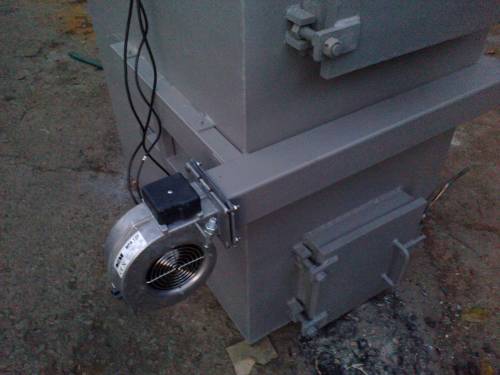
Of the basic tools, you will need a grinder, a drill and a welding machine.
Step-by-step instructions for assembling the pyrolysis chamber:

Also, such a design can be made from a boiler KST, using it as a body.
Brick pyrolysis boiler
You can find out the whole truth about the conspiracy associated with the choice, operation and maintenance of heating boilers of all manufacturers and models.
You can build a stove in your home that will work on the principle of pyrolysis. They are mounted in one of the walls. The chimney is led out onto the roof, the combustion products are removed by natural draft. The combustion chambers are made of steel, the grate is cast iron, the body is made of brickwork... In all other respects, the device is fundamentally no different.
 Brick pyrolysis boiler diagram
Brick pyrolysis boiler diagram
Along the perimeter, the structure is laid out with ceramic bricks, internal partitions are made of fireclay bricks. It is important to produce high quality masonry, as the performance of the furnace will depend on this.
In conclusion, we suggest watching a video on how to make a pyrolysis boiler with your own hands from a gas cylinder:
If you want to receive complete information on this problem, as well as find out other important nuances on the heating boiler from your manufacturer,.
But, we also have on this problem and not only, which in the first place you will not find anywhere, because it is being asked specific people who could not get more support and advice anywhere (which they themselves tell us about). And secondly, their problems are so complex that sometimes our expert Alexander Kholodov deals with people for 10 or more days.
And now EVERY question from the user and the answer to it, in order to avoid money costs as a result of improper operation or repair of the boiler. And here it doesn't matter which manufacturer's apparatus is involved in the issue. The only important thing is that unique situation, as a result of which this issue arose, because as one good saying goes: "if forewarned, then forearmed."

In regions where the only available source heat is coal and wood, long time the most common type of heating equipment was solid fuel boilers... Anyone who has ever lived in a house with such heating knows how inconvenient it is. Of course, you can always install an electric heating device but it is quite expensive to heat a building with electricity. Fortunately, in last years pyrolysis boilers appeared that run on wood or pressed fuel briquettes. All kinds of waste of lump wood are also suitable as "food" for such a unit. The cost of this equipment is quite high, but you can make a pyrolysis boiler yourself. Thus, you will not only significantly save money, but also get a device with the characteristics you need.
The principle of operation of such a boiler is based on the pyrolysis of fuel combustion. This process is often referred to as dry distillation. The fact is that at a temperature of 200–800 ° C under conditions of a certain lack of oxygen, dry wood decomposes into a solid residue or wood coke and pyrolysis gas. Then the resulting gas is mixed with oxygen, which, when sufficient high temperature activates the combustion process.
In this case, the pyrolysis gas interacts with carbon, as a result of which the smoke coming out of the boiler practically does not contain harmful chemical compounds... The solid part of the wood also burns, giving off a certain amount of thermal energy. It should be noted that the pyrolysis process is exothermic, that is, it is accompanied by the release of heat, which is spent on heating and additional drying of the supplied fuel and air.
The advantages and disadvantages of this equipment
So, the advantages:
- Ability long time support required temperature coolant in offline mode. This is possible due to the increased volume of the loading chamber and more high efficiency.
- Low content of carcinogenic substances in combustion products.
- The ability to recycle some waste such as rubber, chipboard, fiberboard or polymers.
But everything would be fine if there were no drawbacks:
- The high cost of the boiler, which can be significantly reduced by starting to manufacture it yourself.
- Large dimensions.
- Demanding fuel. It is very important to use dry wood. When filling the boiler with fuel high humidity the pyrolysis process becomes impossible, the efficiency drops sharply, and a significant part of the thermal energy comes out with steam and combustion products.
- Volatility. For normal work connection to the mains is important for such equipment. This is due to the fact that a small fan must be installed in the boiler, which supports the forced draft.
Classic pyrolysis boiler device
Basic design feature this type of heating equipment is the presence of two combustion chambers. This is necessary for the quality use of the pyrolysis process.
Diagram of the device of the most common "hackneyed" version (click to enlarge)
The first chamber or loading chamber is designed specifically for fuel pyrolysis. The process is only possible with a low oxygen content. This is where firewood is separated into dry residue and gases. Further, the gases enter the second chamber, where secondary air is forcibly supplied, which contributes to the improvement of the combustion process.
The chambers are separated by a grate with briquettes. One more technological feature such a boiler is the top blowing. Due to the increased aerodynamic resistance in the firebox, forced draft is usually used in devices. It can be realized with a smoke exhauster or a blower fan.
How much money do you need to build?
The process of making a pyrolysis boiler yourself is neither simple nor very cheap. So before starting work, you should carefully study all the available information and honestly evaluate your own skills and strengths. But if you still decide on this difficult task, you can save up to 2000 USD. e.
Tools you need
- Welding machine (electric). It is desirable that he was direct current.
- Electric drill.
- Large angle grinder (for circle Ø230). A machine under the circle Ø125 is also desirable, but it is quite possible to do without it.
Required consumables
- Sheet metal 4 mm thick - 7.5 m2. In order to save money, the internal parts of the boiler can be made from a 4-millimeter sheet, and the body from 3 mm.
- Pipe with a diameter of 57 mm with a wall thickness of 3.5 mm - 7-8 m.
- Pipe with a diameter of 159 mm with a wall thickness of 4.5 mm - 0.5 m
- Refractory bricks - 12-15 pieces
- A pipe with a diameter of 32 mm with a wall thickness of 3.2 mm - 1 lm.
- Protruba 60 × 30 with a wall thickness of 2 mm - 1.5 lm.
- Steel strip, 20 mm wide and 4 mm thick - 7.5 lm.
- Protruba 80 × 40 with a wall thickness of 2 mm - 1 lm
- Steel strip, 30 mm wide and 4 mm thick - 1.5 lm.
- 5 packs of electrodes
- Steel strip, 80 mm wide and 5 - 1 lm thick.
- 10 cutting wheels diameter 230 mm
- 5 grinding wheels diameter 125 mm
- Blower fan
- temperature sensor
That's all. Of course, in the process of work, it may become clear that there are some little things missing, but this will not significantly affect either the price of the boiler or the speed of its manufacture.
Complete working diagram for assembly
Definitely before you start self-assembly such serious equipment as a heating boiler, any master needs to draw up a detailed diagram of the future unit. You should not do this "from scratch" (if you are not a heating engineer with extensive experience), it is better to take a ready-made scheme and slightly change it depending on your requirements. Schematic diagram easy enough to find on the net. Here is one of them.

An example of a drawing of a 40kW pyrolysis boiler
A - boiler circuit controller; B - loading door; C - ash pan cover; D - smoke exhauster; E - sleeve for a temperature fuse sensor with a radius of ½ "; F - branch pipe for the emergency line (using a tee in the supply line, it is necessary to install safety valve which is included in the security group kit); G - supply line of the boiler circuit KV; H - supply cold water into the protective heat exchanger R 3/4; K - supply hot water into the protective heat exchanger R 3/4; L - return line of the boiler circuit KR; M - expansion tank and a drain pipe.
![]()
The finished body of the pyrolysis boiler from the inside (explanations in red)
This is a diagram of a Belyaev pyrolysis boiler with a capacity of 40 kW. Of course, with some engineering skills, you can slightly change its design, but this must be done so that the size inner chamber remained the same or changed slightly.
Important! During trial run of a homemade pyrolysis boiler, it is important to determine its efficiency. The easiest way to do this is due to the state of the smoke coming from the chimney. If the smoke is odorless carbon monoxide- The efficiency of your boiler is high enough. It is necessary to check the entire range of operating capacities.
Many pyrolysis boilers provide for the use of not water as a heat carrier, but air. In this case, the hot air is supplied through pipes, and the return flow is carried out by gravity along the floor. This choice has several advantages. Such a heating system is especially convenient in country houses, where the owners are only "arrivals". This is due to the absence of the risk of "defrosting" the system. And it is not necessary to ensure the tightness of the pipes.
Installation and fire safety requirements
When the boiler is ready, it is important to install it correctly. And here we will not talk so much about technical side the question, how much about the rules fire safety... Failure to comply with these rules will not only incur significant fines, but also jeopardize the health or even the life of your family.
- Heating equipment of this type must be installed in non-residential premises- boiler room.
- The base under the boiler must be made of brick or concrete.
- A sheet of metal with a thickness of 1.5-2 mm should be laid in front of the chambers of the furnaces.
- The distance from walls or furniture to the boiler body must be at least 20 cm.
- The room must have a ventilation opening with an area of at least 100 cm2. This is due to the fact that the combustion process requires a constant supply of fresh air.
Important! Insulate the chimney with foil mineral wool... The fact is that the cooling of gases in the chimney shaft will lead to the formation of condensate and tar on its walls, which will negatively affect its safety.
Pyrolysis oven as an alternative to the boiler
Many craftsmen argue that the manufacture of such a boiler with a capacity of less than 15 kW does not make sense. But what about the owners of small country houses, the area of which does not provide for more powerful heating equipment? It might be worth paying attention to the pyrolysis oven. It resembles a pyrolysis boiler in many ways - the principle of operation of such a furnace is based on the same properties of wood combustion.

The insides of the pyrolysis oven (click to enlarge)
To make such a furnace, you will need:
- Ceramic brick- 400 pcs.
- Fireclay bricks - 100 pcs.
- Steel sheet 4 mm thick and 6x1.5 meters in size.
- Blower fan.
- Cast iron grates - 3 pcs.
- Lever thermostat.
- Doors for the combustion chamber and blower.
From these materials you will get a stove with a capacity of up to 25 kW. It will be enough for heating. country house, with an area of about 60 m2. Even if there is a lot of this power for you, it is enough to reduce the dimensions of the stove.
Video of creating a homemade boiler on VIDEO
The main reason for the refusal of most residents of cities and villages from wood-burning boilers in favor of gas heating is a long period autonomous work the latter. In pursuit of convenience, we sometimes lose something important, which we do not pay attention to for a long time. The one who lived in the house with wood heating will never forget the special warmth emanating from the stove and the crackling of logs. Such little things are especially relevant in the country, where most of us come in search of peace, solitude and communication with nature.

